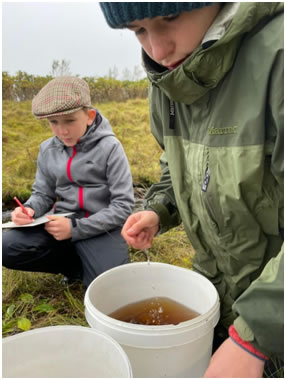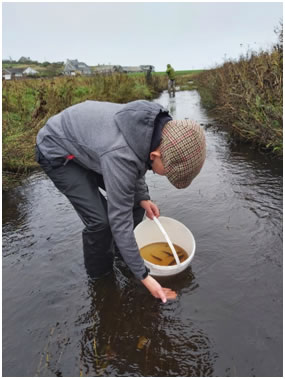![]()
Menu:
Orkney Environment
The Association is committed to the conservation and enhancement of Orkney’s aquatic environment. Our members should be the watch-dogs of the water. Any signs of deterioration and especially pollution must be reported to the Secretary.
 |
|---|
Anglers should ensure that their fishing practices do not compromise the
environment.Fuel tanks should not be topped up whilst afloat.
Members should ensure that their outboard motors are well maintained and
serviced regularly. The Association recommends the use of lead free petrol
in outboards
.Shore toilet facilities should be used at all times.Anglers should take
great care to avoid damage to the waterside or disturbance to wildlife.
No tackle or litter should be discarded on the loch side. Particular regard
should be paid to the hazards to wildlife from monofilament nylon
Sweep Net Report 2023 |
|
|---|---|
 |
|
 |
click here to download The Sweep Net Report and Photographs for 2023 |
Netherbrough Burn – Electrofishing Survey Autumn 2023.
- The Netherbrough Burn is an important spawning burn connected to the Loch of Harray. Its main branch leads up the Lyde road and is about 4.5 miles long and side tributaries add another couple of miles.
- The catchment is dominated by farmland in the lower and middle reaches with heather moorland in the upper reaches. Much of the burn has been straightened in the past although some natural sections remain.
- A site in the upper reaches of the burn (Millhouse) was surveyed annually between 2004 and 2008. Good numbers of trout were found each year.
- This year, multiple electrofishing surveys were carried out to see how juvenile abundance varied in different parts of the burn. These included the Millhouse site so that a comparison could be made to the previous surveys.
- The surveys were carried out in September and October. A single pass survey was carried out at each site which gave a minimum number for trout. The site length and width were also recorded so that the results could be presented as the number of trout per 100m2 of burn (wet area), which is typical for this type of survey and allows comparison to other studies.
- Five sites were surveyed along the main branch of the burn, which are shown on the map below:

- A total of 379 trout were caught at the five sites. Based on the length cohort analysis, the vast majority of these (364, 96%) were aged 0+, i.e. hatched in spring 2023.
- Density varied from 38.0 – 144.4 trout per 100m2.
- These results appeared to compare favourably with national standards for juvenile trout aged 0+ in small burns (<4m width). Godfrey (2005) rated a score in excess of 49.9 trout per 100m2 as Class A (very high). Four of the five sites returned a Class A score.
- The site at Geroin scored 38 trout/100m2, which is still rated as Class B (high). The slightly lower score was unsurprising as the habitat was less suitable there (no spawning gravel and poor instream cover) compared to the other sites.
- Whether Godfrey’s scale is appropriate for Orkney is unclear as it was developed using data from migratory salmonid systems, i.e. salmon and sea trout.
- Trout density (per 100m2) at Millhouse, the most upstream site, was similar to previous surveys:
- 2004: 104.8
- 2005: 120.9
- 2006: 231.2
- 2008: 133.8
- 2023: 144.4
 |
|---|
| Trout going back to the burn at Millhouse, the furthest upstream site. |
- The mean length of 0+ trout was similar at four sites, being around 75mm. However, 0+ trout at Millhouse were smaller on average at 66mm. Decreasing size with upstream distance has been noted in other Orkney burns.
- Only 15 trout aged 1+ or older were found in the survey. This is not of immediate concern as these surveys focussed on sites that were shallow and more suited to 0+ trout. Larger, older trout seek out deeper water where electrofishing is less effective.
- It is also possible (likely?) that a large proportion of trout migrate into the Loch of Harray at age 1, which would also explain the lack of older fish.
- These data allow a very crude estimate of productivity that suggests the main section of the Netherbrough burn produced a minimum of 13500 trout aged 0+ in 2023.
- Note this is a minimum estimate that would rise with the addition of the burn’s smaller tributaries. It should also be noted that a single pass electrofishing run only catches 60-70% of the trout present assuming good fishing efficiency.
- This is an extremely coarse calculation but it gives some food for thought. It would be interesting to know more about the migration of juvenile trout from spawning burns into the Loch of Harray. For example, what is the age structure of fish when they enter the loch? When do they migrate into the loch? Is this migration similar across all Harray’s burns? Lots of questions to ponder.
- The OTFA is extremely grateful to landowners for permitting access to the burn, including Gary Sinclair (Drunton), Mitch Flett, Ian Flett (Millhouse), Daniel Henry (Howe), John Yule and Keiron Moar (Eastaquoy)
 |
|---|
Much of the Netherbrough Burn has been straightened in the past, but the instream habitat is recovering in places. |
Woodwick Burn Survey, October 2021
The Woodwick Burn in Evie is a medium sized Orkney burn that drains into the sea at the Bay of Woodwick. It is known to support a population of brown trout, some of which migrate to sea each spring to become sea trout, before returning to the burn to spawn. It is one of seven burns located between Birsay and Kirkwall that are known to support sea trout.
 |
|---|
The upper reaches of the Woodwick Burn, looking downstream to the sea.
A simple habitat survey of the Woodwick burn was carried out in October 2020 as part of a planned expansion of the Hammars Hill wind farm, located in the upper part of the Woodwick catchment area. This survey found a number of interesting features, including three fish ladders, abundant loose flagstones and a section in the middle reaches of the burn, approximately 200m long and up to 10m wide, composed entirely of smooth sloping bedrock. The burn follows a natural route over most of its length, which is actually quite rare for burns on the Orkney Mainland.
A year later, in October 2021, OTFA members carried out an electrofishing survey to find out more about the trout population in the burn. Two sites were sampled: a downstream site (just above the dam at Woodwick Mill) and an upstream site (at Savisgarth). The results were as follows:
- At the downstream site, a total of 35 trout were caught in 18 minutes of electrofishing, or 1.9 trout per minute. At the upstream site, 21 trout were caught in 19 minutes of electrofishing, or 1.1 trout per minute. Both results equate to moderate density, according to a scale suggested by the Wester Ross Fisheries Trust
- Trout size ranged from 65mm to 178mm. No scale samples were collected but length frequency data suggested that the trout were aged 0+ (hatched spring 2021), 1+ and 2+ yrs.
- All the trout in the sample were freshwater residents. No sea trout were found.

Length frequency analysis of trout caught Burn of Woodwick, October 2021 (upstream & downstream sites combined).
- Trout density was higher at the downstream site, mainly because 0+ trout were more abundant there. However, at the upstream site, quite a few 0+ trout escaped the handnets – if they weren’t caught immediately they disappeared into the shelter of the flagstones and boulders that dominated the streambed there. Perhaps we were a bit out of practice too! If those trout had been caught then the two samples would actually have been very similar in terms of density and age structure.
- Mature male trout (N = 3) were present found at the upstream site and all were aged 2+ or older.

Mature male trout at the upstream site.
- Mean growth (fork length) was 78.7mm, 125.5mm and 158.1mm for 0+, 1+ and 2+ aged fish, respectively. These are similar to growth rates measured in other trout burns on the Orkney Mainland.
These results suggest the Burn of Woodwick supports a relatively healthy population of brown trout. The presence of trout above the bedrock section in the middle of the burn was interesting, but the ease with which trout move past this potential obstacle remains unknown. Similarly, the ability of trout, both resident and sea trout, to navigate upstream through the fish ladders in the burn remains an area of interest. Mature trout need access to spawning habitat and this is particularly important for female sea trout, as they contribute many more eggs than females that reside in freshwater. In burns such as Woodwick, which has no lochs, female sea trout are probably responsible for the vast majority of eggs laid each winter. No sea trout were found on this occasion, which was not too concerning given it was a spot survey and limited in extent. Future survey work will aim to examine these issues.
 |
 |
|---|
OTFA junior members Joe Thomson and Magnus Kirkpatrick take notes. All trout were safely returned to the burn afterwards.
This marks the first electrofishing survey carried out by the OTFA for some time and hopefully 2022 will see more work undertaken to gauge the current health of trout populations across Orkney. This survey was carried out by OTFA members Malcolm Thomson and Colin Kirkpatrick, ably assisted by junior members Joe Thomson and Magnus Kirkpatrick. The OTFA is grateful to landowners Micky Austin, Brian Thomson and Richard Jenkins for providing access to the burn for this survey.